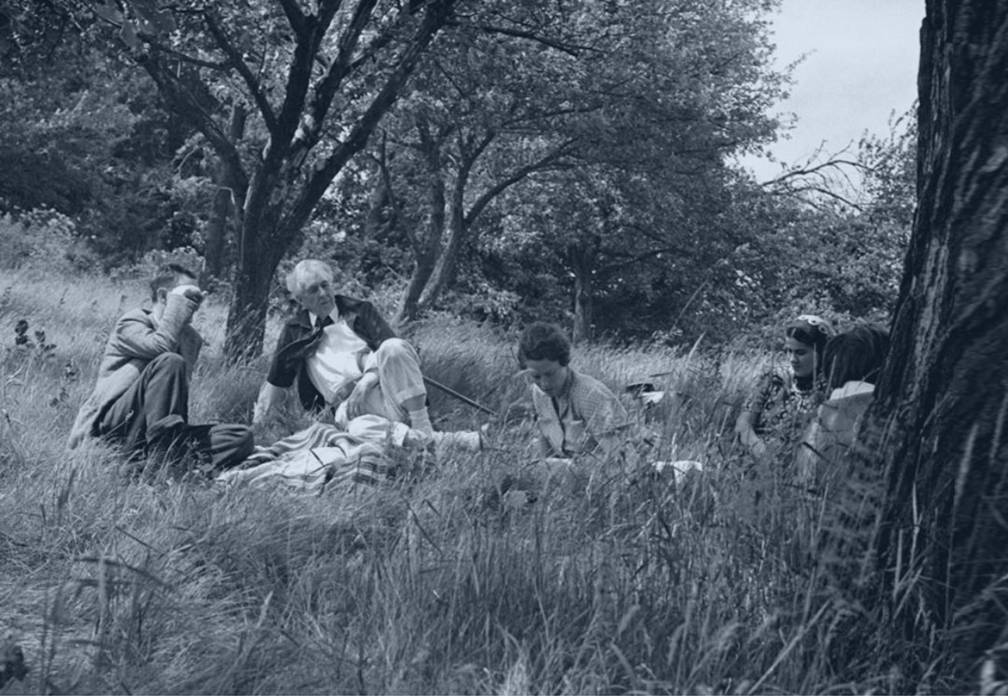The History of the French Picnic

TWO CENTS | MAR 20, 2021
The History of the French Picnic
In the 18th and 19th centuries, picnics were composed of fancy beverages and elaborate meals, sometimes taking days to prepare.
When I think of the word picnic, I’m reminded of a small basket I used to play with as a child. Inside amidst a frenzy of elastic hooks sat small utensils, cups, and plates of varying sizes. The contents were so overwhelming that I would open it solely to admire its organizational charm, before closing it tightly to shove it back into its rightful place. Sure, the idea of a picnic sounded nice, but the path to get there and back did not. After enjoying a pleasure filled thirty or so minutes in the great outdoors, you’d find yourself stuck with a pile of sticky forks, half consumed liquid in cups, and pastry crumbs stuck to porcelain plates. This, combined with the thought of washing, drying, and repositioning the items back into their correct places was the reason I never aspired to be someone who picniced.
Now, moving past this messy aftermath, let's imagine it’s the year 1783 and you reside in northern France. You’re a wealthy socialite, and good friends with Marie Antoinette. You’re invited to Le Hameau de la Reine, or the Petit Hameau, a retreat constructed on the grounds of Versailles to resemble a sort of mock-style farmhouse – complete with dairy and poultry yards – within an English garden setting. On most occasions at Petit Hameau, you, along with many others, dress up in simple costume, sometimes as shepherdesses pretending to milk cows, or as village women with silk ribbons tied around your waist. You enjoy an evening of relaxed festivities and seasonal food surrounded by other wealthy women. To you, this is ordinary – leisurely even.
In 18th century France, picnics like the one depicted were composed of fancy beverages and elaborate meals, sometimes taking days to prepare. Versailles was a common place for this, where French royalty would dress up for a day to enjoy good company and food. Although the idea was to mimic the simple pleasures of peasant life, which were not very pleasant, the set up was everything but. I’d imagine this spectacle rubbed people the wrong way, but fortunately for common folk, the picnic did evolve into a much simpler occurrence.
After the French Revolution in 1789, when ordinary people were allowed to gather in the country's royal parks, picnicking began to grow in popularity, making its way into artwork like Claude Monet’s Le Déjeuner sur l'herbe, James Tissot’s Holyday, and Jean-Baptiste Pater’s Fête Champêtre, which, when translated means an outdoor feast or entertainment. Once the picnic began to make its way into everyday life, it became a well loved social activity throughout much of France and parts of Europe – and I must say, if I were a Parisian during this time I’d happily embrace the picnic with open arms.
The food served would often be an assortment of cheese – comté (cow’s cheese) or chèvre frais (goat’s cheese) – meat, baguettes, pastries, and seasonal fruit. In the fall: fresh figs, mangos, pears, and bananas. In the winter: apples, clementines, oranges, grapefruit, and persimmon. In the spring: litchi, raspberries, passionfruit, and strawberries. And in the summer: cherries, peaches, nectarines, and watermelon.
Aside from its depiction in Impressionist artwork, the picnic came to life on fabric, too. The “Toile de Jouy,” or in English “fabric of Jouy,” was a pattern coined by designer Christophe-Philippe Oberkampf in the late 18th century. It was printed at Jouy-en-Josas, a factory outside of Paris, and is still used to this day. Oberkampf’s designs ranged from simple florals to French country life, of note: picnics.
In her book A Ritual of Dinners, Margaret Visser shares the impromptu aspect of the 19th century picnic, its organization similar to that of a potluck: pleasantly simple, informal, and lacking set courses. Just like 18th century gatherings where French aristocracy would meet for a formal day of costume and a sit down meal in the countryside, picnics after the French Revolution remained a “relief against normal constraints.” This mindset I appreciate, one that isn’t so different from say, wine paired with a charcuterie board on a summer day, having a cocktail on a patio, or reading a book while laying on a blanket in the park. For me, the picnic involves a shift in thought, to take smaller forms of social outdoor excursion one step further. When compared to the picnic, these activities are equivalent to dipping a toe in the pool, but not fully enjoying the water.
As Visser so elegantly puts it, “we are very self-conscious about picnics, and the freedom we grant ourselves to lounge about on a blanket eating cold food with our hands.” She adds, “Fresh air and natural beauty, adventure, no cooking, and no tables and chairs – a good picnic is a thrilling reversal of normal rules.” While meals are typically structured, the picnic is not. The food you bring with you, however, might be the one constant. Nearly two centuries later, the menu hasn’t changed. If you were planning a picnic, along with meat, cheese, fruit, and bread, you might also pick up pastries from a bakery: macaroons, palmiers, and if you happen to be in France, a satisfying dark chocolate tarte de chocolat.
To carry this collection of food, I’ll admit, a picnic basket would come in handy. If you were to purchase one today, it would be mostly the same. The exterior would be a woven wood material (willow, perhaps?) with a cushioned handle made of a more refined material like faux leather. The inside a delicate fabric, striped nautical or gingham, to reinforce the idea that picnics are fun. On top you’d find plates and silverware held together by a myriad of straps, which at first might seem unnecessary, but on closer inspection are very necessary. On the bottom, glasses would sit cozied between elastic straps, ready to be filled with the drink of your choice. Where you’d wash your dishes once you’re finished I still do not know. In a river, perhaps?
-
Kayla Kirby is a writer working remotely with brands in New York and elsewhere to create content that changes the way brands and communities interact.
SIMILAR ARTICLES




